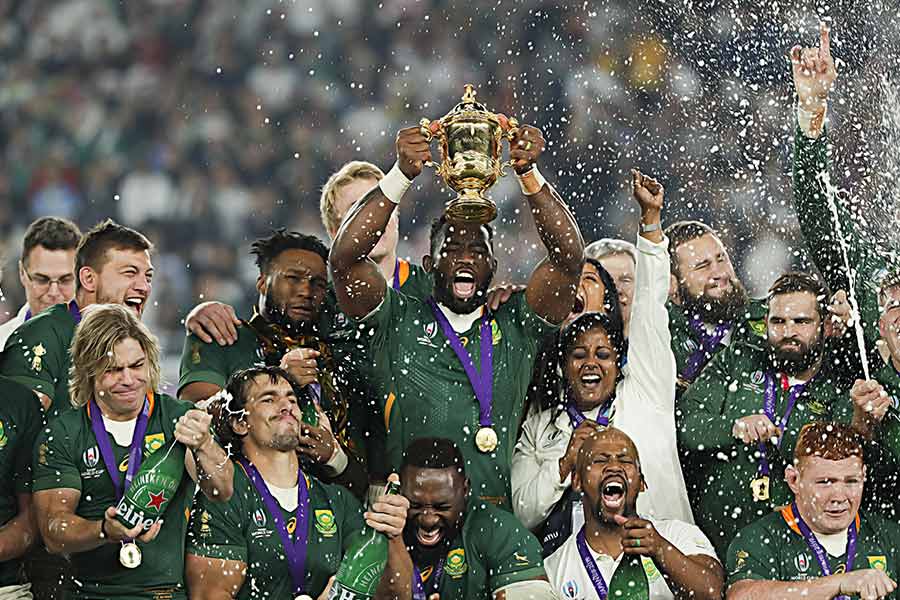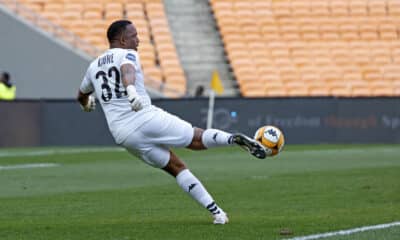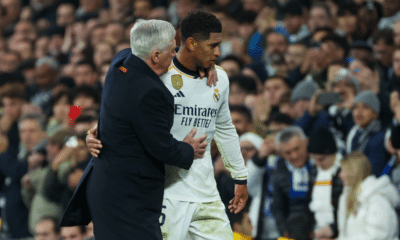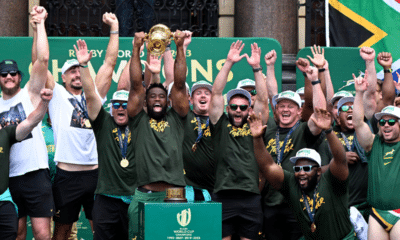
11 November 2019, by: Quintin van Jaarsveld
Comparing Three Generations of Bok RWC Winners
Quintin van Jaarsveld looks at the three generations of Rugby World Cup-winning Springboks and selects an All-Star side.
Be it destiny or serendipity, Siya Kolisi and his team ensured South Africa’s 12-year cycle between global glory continued when they annihilated England 32-12 in the final in Yokohama recently.
It all started on home soil in 1995, when Kitch Christie’s charges triumphed against all odds, edging the All Blacks 15-12 in an extra-time thriller for the ages at Ellis Park. Come 2007, Jake White’s men followed suit when they saw off England 15-6 in Paris and Rassie Erasmus’ men have now joined the elite group of Green and Gold World Cup winners.
How do the Springbok stars who started those finals compare? Who is the best of the best? It’s a topic for much debate, as every player is a legend in his own right, and certainly not an exact science. We’ve considered players’ careers as a whole, their performance in the final and their greater significance to team and country. Even then, each case is unique, with the variables not necessarily carrying the same weight across the board.
GET THE ADVANTAGE WITH OUR RUGBY BETTING OFFERS
Extensive pre-match and live in-play markets on every game.
Our legendary BET Boosts to give you extra value on every game!
Exclusive to BET.co.za customers.
Players with contrasting skillsets and attitudes toward the game. Joubert was the most well-rounded of the three; “The Rolls-Royce of Fullbacks” could do it all and adapted according to match situations. Montgomery, particularly in the twilight of his career in 2007, was a low-risk tactician and excellent goal-kicker, while Le Roux was a playmaker with an attacking mindset.
Joubert is arguably the more revered, and famously played the semi-final and final with a broken hand. Montgomery, however, had the more decorated career and played a more integral role in the class of 2007’s triumph. “Monty” slotted four pressure penalties in the final and was the tournament’s top point-scorer with 105.
Three completely different characters who each had major hands in their teams’ success. Pietersen saved the day with a try-saving cover tackle on Fiji lock Kele Rawaqa in the quarter-finals, when the Pacific Islanders threatened an upset, while Kolbe – the pocket-rocket of the three flyers – was the magic man of the 2019 vintage and managed what neither Small or Pietersen could – cross the whitewash in a final.
Small, however, had the greater impact in the 1995 decider as he famously did the seemingly impossible – stop the runaway freight-train that was All Blacks behemoth Jonah Lomu. Legacy wise, the larger-than-life Small – who passed away earlier this year – was one of rugby’s greatest rebels and finished his career as the Springboks’ record try-scorer.
Even though Mulder, who cut down Lomu with a legendary one-on-one tackle, and Fourie were both rock-solid, Am produced the best final performance. Offensively outstanding, Am sliced through the England defence on a number of occasions and had a vital hand in both Makazole Mapimpi and Kolbe’s historic tries.
That said, Fourie didn’t put a foot wrong at the Stade de France AND is widely regarded as South Africa’s best-ever outside centre with his unrivalled genius as the backline’s defensive general, high rugby IQ and strong and skillful ball-carrying.
Le Roux was solid rather than spectacular as flyhalf-cum-inside centre, while a fresh-faced Steyn showed maturity well beyond his years when he was thrust into the starting line-up early on after Jean de Villiers suffered a tournament-ending injury in 2007. He kicked a long-range penalty to give the Springboks a nine-point buffer late in the second half of the final and became the youngest-ever World Cup winner at just 20 years of age.
Mostly used as a versatile super-sub in this year’s tournament, Steyn replaced Le Roux in the 67th minute of the Yokohama final. De Allende was arguably the Springboks’ best player and one of the stars of the tournament with his hard-running and delivered in the decider as well. For the career he’s had, and for capping it off by becoming only the second-ever two-time World Cup-winning South African player, Steyn stands tall.
Three fantastic finishers, all of whom excelled on the biggest stage. Williams, drafted in for the suspended Pieter Hendriks, became a national treasure and as the only black player in the 1995 team, has a transcendent, trail-blazing place in South African rugby history. Like teammate Small, he passed away earlier this year.
Mapimpi was magnificent in Japan, scoring six five-pointers, second only to Wales’ Josh Adams (7), including South Africa’s first-ever try in a World Cup final. Habana, however, was a peerless predator. He emulated Williams when he scored four tries in the pool game against Samoa, went on to tie Lomu’s record of eight tries in a single World Cup and snapped up the World Rugby Player of the Year award. Eight years later, he equalled the All Blacks great’s all-time World Cup record of 15 tries and is the Springboks’ all-time top try-scorer with 67.
Both Stransky and James lifted their game considerably to steer the Springboks to World Cup glory. Pollard came good in the play-offs, producing a Man of the Match performance in the 19-16 semi-final win over Wales, in which he slotted five-from-five off the tee, and scored a record 22 points in the final, which saw him finish as the tournament’s top point-scorer with 69.
Stransky will forever be remembered for his nerves of steel in the epic 1995 final, and his legendary performance – which saw him kick three penalties and a drop-goal before slotting THAT iconic, title-clinching drop – will be hard to top. He kicked off the tournament by making history as well, becoming the first-ever Springbok to score in all four ways possible (try, conversion, penalty and drop goal) against Australia.
Van der Westhuizen and Du Preez are two of the all-time greats, while De Klerk was the key man in Erasmus’ kick-heavy game plan. That style was perfected by none other than Du Preez, and while De Klerk was spot-on with his tactical-kicking in the final, Du Preez’s prowess in that regard remains unparalleled. He was his team’s most valuable player and produced perhaps the best scrumhalf showing in World Cup history in the 36-0 win over England in the pool game in Paris.
Van der Westhuizen was one of the game’s great giants, a Hall of Famer who was not just instrumental in the 1995 triumph, but captained South Africa in the 1999 World Cup and remained a key figure during the 2003 tournament. In a career full of highlights, his shining World Cup moment was the legendary tackle on Lomu that set the tone for the Springboks’ physical dominance in the 1995 decider. Without Du Preez, the Springboks of 2007 probably wouldn’t have reigned supreme and he therefore eked out Van der Westhuizen.
A much more cut and dry case, Vermeulen cemented his legacy with his colossal Man of the Match performance in Yokohama. He was also the only out-and-out No.8 with both Andrews and Rossouw having been retread locks. Andrews did as good of a job as one could’ve hoped for a player whose only prior Test at eighthman was the previous week’s semi-final showdown with France.
Rossouw, who had considerably more back-row experience than Andrews as a utility forward, famously nudged Mark Cueto into touch with a grazing try-saving cover tackle in one of the most significant moments of the 2007 final. Vermeulen, in his standout effort, showed the value of a specialist No.8. The 33-year-old led the physical surge as a one-man wrecking crew with ball-in-hand and on defence and won two breakdown penalties to cap off a complete performance.
Kruger was known as “The Silent Assassin” and was, indeed, one of the unsung heroes of the 1995 Springboks with his impeccable workrate. He crossed the whitewash for what referee Ed Morrison later admitted was probably a try. The England official on the day ruled that the ball had been held up, and South Africa had to wait 24 years for their first final five-pointer.
Smith was a special talent – incredibly consistent, a powerful ball carrier, tireless tackler and a great lineout jumper. He’s regarded by many as the best blindside flank in Springbok history. At 27, Du Toit is already challenging for that distinction. Our pick and a two-time South African Player of the Year, he was one of the Springboks’ shining stars in the Land of the Rising Sun and returned home with the World Rugby Player of the Year award.
Few would argue that Burger was the best player of the three. Tough-as-nails, he was twice named South African Player of the Year and won the World Rugby Player of the Year award in 2004. This is a case where, in the bigger scheme of things, Burger takes a backseat.
Pienaar and Kolisi were the perfect men at the perfect time to lead the Springboks to glory. Class acts on and off the field, they led by example, pouring their hearts and souls into their missions to capture the Webb Ellis Cup, knowing full well the national-building impact it would and indeed did have.
Pienaar, who was in the stands to watch the 2019 breed of Springboks batter England in the final, said Kolisi and company’s trophy triumph trumped that of his team in 1995, saying, “This is bigger because it is a transformed team, 58 million people watching in South Africa yesterday morning, and all races would have woken up wearing green, which wouldn’t have happened in my time.”
The iconic image of Pienaar receiving the trophy from Nelson Mandela, wearing a Springbok No.6 jersey of his own, is embedded in the hearts and minds of all South Africans. From a general point of view, its powerful message of racial reconciliation will never be topped.
In sporting terms, specifically, the image of Kolisi – the Springboks’ first black captain – lifting the cup is more significant as it’s set to do more for transformation of a historically white-dominated game than the polarising, politically-charged quota system ever has or will. It’s for this reason that Kolisi is our All-Star openside flank.
As a physical specimen and a second-rower, Strydom was solid as a rock. De Jager had boarded the plane to Japan as a member of “The Bomb Squad” (a name the replacements adopted) but soon made the No.5 jersey his own through towering and tireless performances. Unfortunately for De Jager, he was forced off 21 minutes into the final due to injury. Mostert stepped up and stood tall with a team-high 15 tackles.
As good as these three were, there’s only one Matfield. A once-in-a-lifetime lock, he ran the lineout like clockwork, studying hours of tape to get a leg up on the opposition. He produced a Man of the Match performance against the English in the 2007 final and remains the most-capped Springbok of all-time (127).
Hard men among hard men. A brick house of a man, Wiese wasn’t the most athletic lock in the world, but few with a four on their backs were back in 1995. He beefed up the pack, provided punch and never took a backward step. Etzebeth has been an excellent enforcer and although he wasn’t quite at his beastly best in Japan, he rose to the occasion in the final.
When you think about the most feared players of all-time, Botha’s name is the first that comes to mind for most rugby lovers worldwide. The personification of ruthless aggression, he made a habit of smashing sides into submission, gave South Africa go-forward and was a perfect partner for the more streamlined and cerebral Matfield.
This was the toughest call to make. Swart, a smart and technically-gifted scrummager – who’d eventually carve out a highly-successful coaching career as a scrum guru – played in only four tournament fixtures. His was a case of quality over quantity. Malherbe, meanwhile, needed time to find his footing but when he did, at the most opportune time in the final, he was terrific. On top of a monstrous scrummaging effort, he put in a ton of work across the park, making no less than 11 tackles.
Van der Linde was a titanic force who gave the 2007 side a strong scrummaging platform and was the best ball-carrier of the three. While Malherbe had the best final of the tighthead trio, Van der Linde was the most consistently world-class performer over the course of his 75-Test career, which included a second World Cup in 2011, and had the added value of being a swing prop. Like Swart, he went into coaching and is currently the scrum coach of French club Montpellier.
Rossouw was thrust into the starting XV after first-choice James Dalton was red-carded and subsequently suspended for his role in “The Battle of Boet Erasmus” and slotted in seamlessly. While he’s one of the less-heralded members of the 1995 team, he did his job and he did it clinically.
Mbonambi had a magnificent 2019 tournament in all facets, form that saw him unseat Marx as first-choice hooker. He was one of the hardest-working and hardest-hitting defenders and was machine-like with his lineout throwing, with the Springboks remarkably only losing their first lineout in the semi-final clash with Wales. Like De Jager, he limped off in the 21st minute of the final and like Mostert, Marx was massive off the bench, making 11 tackles and winning a penalty with his breakdown brilliance.
This is another instance where a player’s overall value won out. An extension of coach Jake White on the field, Smit’s leadership skills and vast experience were immeasurably important and his set-piece play was exemplary as well. His legacy as Springbok captain is unrivalled and he’s one of only six South African Test centurions.
Both are All-Stars – two absolute legends who are universally loved and respected. Colossal scrummagers, bulldozing ball carriers and devastating defenders, they were unstoppable and indestructible Green and Gold tanks. “The Beast” bowed out with a vintage final frontier in which he decimated the England scrum with roaring intensity and power, carried strongly and made eight tackles. The most-capped prop in Springbok history, his 117th and final appearance was one of the best of his illustrious career.
Du Randt started and finished his career on top, becoming the first Springbok with two World Cup winner’s medals after leading the way upfront in 1995 and 2007. The fact that he achieved this 12 years apart is a testament to the legendary loosehead’s professionalism and longevity.
As aforementioned, Steyn has now joined Du Randt as a two-time World Cup winner, however, whereas the former fulfilled a super-sub role the second time around, the latter was once again the starting warhorse. The South African Player of the Year in 1997 and Players’ Player of the Year award in 2004, Du Randt was inducted into the World Rugby Hall of Fame at this year’s World Rugby Awards, and will no doubt be joined by Mtawarira in the not too distant future.
15 Percy Montgomery, 14 James Small, 13 Jaque Fourie, 12 Frans Steyn, 11 Bryan Habana, 10 Joel Stransky, 9 Fourie du Preez, 8 Duane Vermeulen, 7 Pieter-Steph du Toit, 6 Siya Kolisi, 5 Victor Matfield, 4 Bakkies Botha, 3 CJ van der Linde, 2 John Smit, 1 Os du Randt.
JOIN BET.CO.ZA NOW AND GET 100% DEPOSIT MATCH UP TO R1000
Open your BET.co.za account here
Deposit using your preferred method
Your bonus gets added immediately!
MORE RUGBY























